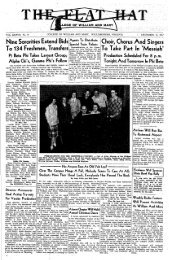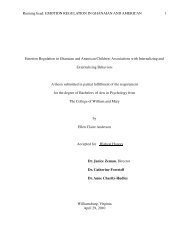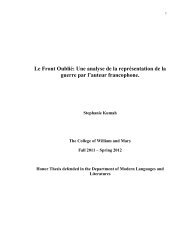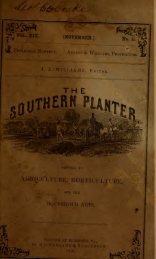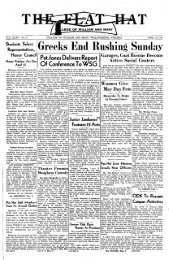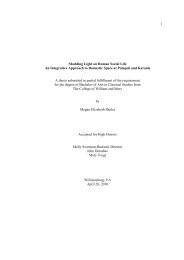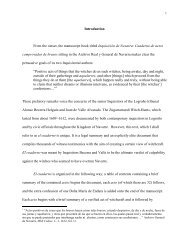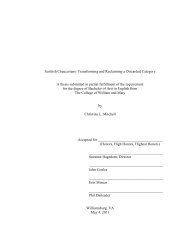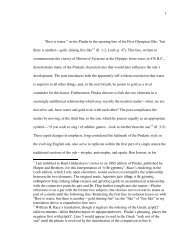Southern planter : devoted to agriculture, horticulture, and the ...
Southern planter : devoted to agriculture, horticulture, and the ...
Southern planter : devoted to agriculture, horticulture, and the ...
Create successful ePaper yourself
Turn your PDF publications into a flip-book with our unique Google optimized e-Paper software.
TH E<br />
Devoted <strong>to</strong> Agriculture^ Horticulture^ <strong>and</strong> <strong>the</strong> Household Arts.<br />
K^i.<br />
Agriculture is <strong>the</strong> nursing mo<strong>the</strong>r of <strong>the</strong> Arts.] Tillage <strong>and</strong> Pasturage are <strong>the</strong> two breasts of<br />
<strong>the</strong> State. Sully.<br />
—Xenophon. \<br />
FRANK. G. RUFFIN, Edi<strong>to</strong>r. AUGUST & WILLIAMS, Pkop'rs.<br />
Vol. XYIII. RICHMOND, YA., JULY, 1858. NO. T.<br />
From <strong>the</strong> Canadian Agriculturist,<br />
Laying" Farm-Yard Dnng on Clay Fal-<br />
lows for Wheat.<br />
The preparation of clay l<strong>and</strong>s for a succession<br />
of crops by <strong>the</strong> process of summer fallow-<br />
ing, which pulverizes <strong>the</strong> soil <strong>and</strong> removes all<br />
weeds <strong>and</strong> s<strong>to</strong>nes, reaches <strong>the</strong> condition of receiving<br />
farm-fard dung for manure in <strong>the</strong> end<br />
of August or during <strong>the</strong> month of September.<br />
Early operations are <strong>the</strong> most effectual, <strong>and</strong> <strong>the</strong><br />
best performances get <strong>the</strong> l<strong>and</strong> ready in August<br />
for <strong>the</strong> reception of lime <strong>and</strong> dung. The first<br />
article, in a pulverized condition, is spread<br />
evenly over <strong>the</strong> l<strong>and</strong>, <strong>and</strong> harrowed in<strong>to</strong> <strong>the</strong><br />
ground by a double tine of <strong>the</strong> common-purpose<br />
harrows. The farm-yard is laid in small<br />
heaps on <strong>the</strong> l<strong>and</strong>, spread by <strong>the</strong> h<strong>and</strong>-forks<br />
evenly over <strong>the</strong> surface of <strong>the</strong> ground, <strong>and</strong><br />
covered by one furrow of <strong>the</strong> plough. The<br />
dung may be carried in <strong>the</strong> fresh condition<br />
from <strong>the</strong> cattle yards, being <strong>the</strong> production of<br />
<strong>the</strong> latest s<strong>to</strong>re cattle, <strong>and</strong> from <strong>the</strong> soiling<br />
beasts that consume <strong>the</strong> green food, or it may<br />
have been placed in a heap on <strong>the</strong> field of l<strong>and</strong><br />
from <strong>the</strong> month of March <strong>to</strong> <strong>the</strong> time of use,<br />
<strong>and</strong> will have reached a partially, if not a halfrotten<br />
condition, when it is spread over <strong>the</strong><br />
ground in August. The lumps of dung will<br />
•often not be covered by <strong>the</strong> plough, <strong>and</strong> lie on<br />
<strong>the</strong> surface, being pushed, before <strong>the</strong> coulter,<br />
<strong>and</strong> not falling in<strong>to</strong> <strong>the</strong> bot<strong>to</strong>m of <strong>the</strong> furrow.<br />
A lad or woman with a h<strong>and</strong>-fork fullows <strong>the</strong><br />
plough, <strong>and</strong> throws <strong>the</strong> pieces of dung in<strong>to</strong> <strong>the</strong><br />
25<br />
—<br />
hollows^ where <strong>the</strong>y are covered immediately<br />
by <strong>the</strong> next furrow of ploughing. This provision<br />
is made against <strong>the</strong> loss by evaporation<br />
from exposure of dung on <strong>the</strong> surface of <strong>the</strong>^<br />
ground ; but <strong>the</strong> <strong>the</strong>ory'- of loss from exposure'<br />
does not yet hold a confirmed dominion among<br />
undoubted facts.<br />
The common plough opens drills with onefurrow<br />
at convenient distances for green crops,,<br />
<strong>and</strong> on light soils <strong>the</strong> dung is well covered by<br />
one furrow of earth being laid over it. Clayl<strong>and</strong>s<br />
for wheat are drilled; in <strong>the</strong> same way by<br />
one furrow, <strong>the</strong> dung is spread along <strong>the</strong> hollows,<br />
<strong>and</strong> covered by splitting <strong>the</strong> ridglets with<br />
<strong>the</strong> plough. In this way <strong>the</strong> plough opens a<br />
drill in going <strong>the</strong> length of <strong>the</strong> field, <strong>and</strong> in returning<br />
covers a drill of dung by reversing <strong>the</strong><br />
furrow. This mode covers <strong>the</strong> dung very completely,<br />
<strong>and</strong> exhibits <strong>the</strong> field in <strong>the</strong> form of<br />
drills ;<br />
not highly raised, or widely formed, as<br />
for green crops, but flatly done, <strong>and</strong> executed<br />
for <strong>the</strong> sole purpose of covering <strong>the</strong> dung from<br />
exposure. A cross harrowing is required <strong>to</strong><br />
level <strong>the</strong> ground when <strong>the</strong> l<strong>and</strong> is seed-furrowed<br />
in Oc<strong>to</strong>ber. The two drillings of one farrow<br />
are less labour than one ploughing, <strong>and</strong> cover<br />
<strong>the</strong> dung much better. Even <strong>the</strong> harrowing<br />
that is required before <strong>the</strong> seed-furrow, does<br />
not raise <strong>the</strong> expense <strong>to</strong> an equality with <strong>the</strong><br />
ploughing of <strong>the</strong> dung in<strong>to</strong> <strong>the</strong> ground.<br />
The wet nature of moist clay l<strong>and</strong>s prevents<br />
<strong>the</strong> carting of dung on <strong>the</strong> surface in Oc<strong>to</strong>ber,,<br />
<strong>and</strong> consequently, <strong>the</strong> manure must be applied<br />
at an earlier period, <strong>and</strong> <strong>the</strong> l<strong>and</strong> ploughed<br />
again for <strong>the</strong> sowing, of seed. Cases occur-



